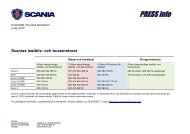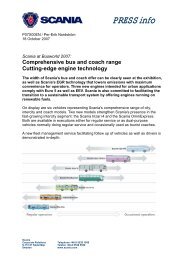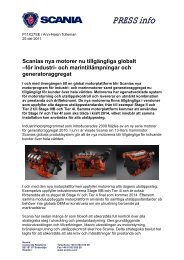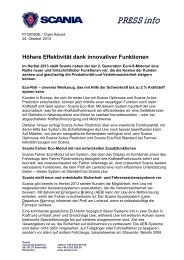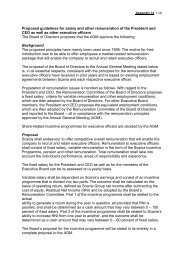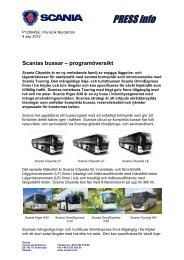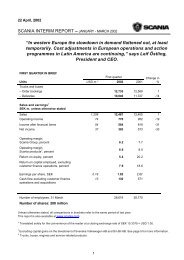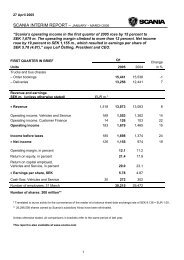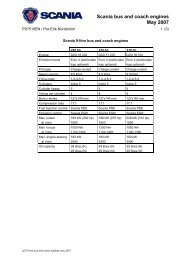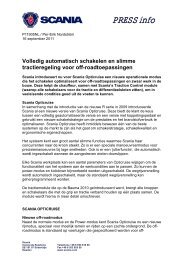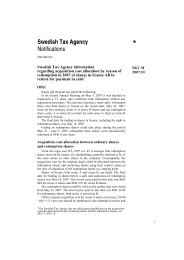Scania annual report 2004
Scania annual report 2004
Scania annual report 2004
Create successful ePaper yourself
Turn your PDF publications into a flip-book with our unique Google optimized e-Paper software.
Note 29 continued<br />
Interest-bearing<br />
Interest-bearing<br />
Interest rate refixing Customer Finance liabilities (including<br />
in Customer Finance portfolio 1 interest rate derivatives) 2<br />
2005 14,767 14,102<br />
2006 5,160 4,816<br />
2007 3,533 2,439<br />
2008 1,911 668<br />
2009 1,008 520<br />
2010 and later 217 18<br />
Totalt 26,596 22,563<br />
1 Including operating leases.<br />
2 Other funding consists mainly of shareholders’ equity.<br />
<strong>Scania</strong>’s total borrowing portfolio, related to borrowing for Customer<br />
Finance operations and for Vehicles and Service, amounted to SEK<br />
25,613 m. (26,208) at year-end <strong>2004</strong>. The effective interest rate on<br />
borrowings was 3.5 (3.6) percent.<br />
Borrowings and Borrowings Borrowings Effective<br />
effective excluding swap including swap interest rate<br />
interest rate agreements agreements in percent 1<br />
SEK 7,295 3 2.1<br />
EUR 15,195 18,089 2.7<br />
GBP 336 1,608 5.3<br />
USD 71 414 3.8<br />
KRW 491 1,157 4.0<br />
Other 2,225 4,342 5.8<br />
Total 25,613 25,613 3.5<br />
1 Including currency and interest rate derivatives.<br />
Credit risk<br />
Credit risk is defined as the risk that the counterparty in a transaction<br />
will not fulfil its contractual commitments and that any collateral will not<br />
cover the company’s claim.<br />
An overwhelming share of the credit risk for <strong>Scania</strong> is related to<br />
receivables from customers. <strong>Scania</strong> sales are distributed among a large<br />
number of end customers with a large geographic dispersion, which<br />
limits the concentration of credit risk.<br />
The credit portfolio including operating leases in Customer Finance<br />
operations amounted to SEK 26,596 m. (25,926). To maintain a controlled<br />
level of credit risk in the Customer Finance segment, the process of<br />
issuing credit is supported by a credit policy as well as credit instructions.<br />
Credit risks are managed by active credit monitoring and administration<br />
of customers who do not follow the agreed payment plan. Collateral in<br />
Customer Finance operations mainly exists in the form of the products<br />
being financed. Provisions for bad debts from customers are based on<br />
an individual assessment of each customer, based on the customer’s<br />
payment capacity, expected future risk and the value of the underlying<br />
collateral. Provisions for credit losses amounted to 1.9 (1.8) percent of<br />
the total Customer Finance portfolio.<br />
The table below shows the credit risk exposure in Customer Finance.<br />
Concentration of<br />
Percentage of<br />
credit risk in Number of total number Percentage of<br />
Customer Finance customers of customers portfolio<br />
Exposure < SEK 15 m. 20,345 99.0 68.4<br />
Exposure SEK 15 – 50 m. 177 0.8 17.2<br />
Exposure > SEK 50 m. 33 0.2 14.4<br />
Total 20,555 100 100<br />
In the Vehicles and Service segment, receivables from customers totalled<br />
SEK 8,648 m. (7,499), most of which consisted of receivables from<br />
independent dealerships and end customers.<br />
The administration of the financial credit risks that arise primarily in<br />
corporate treasury operations, among other things when investing liquidity<br />
and in derivatives trading, is regulated in <strong>Scania</strong>’s financial policy.<br />
Transactions occur only within established limits and with selected,<br />
creditworthy counterparties. “Creditworthy counterparty” means that the<br />
counterparty has received an approved credit rating from Standard and<br />
Poor’s and/or Moody’s. To reduce credit risk, the volume of exposure<br />
allowed per counterparty is limited, depending on the counterparty’s<br />
credit rating. To further limit credit risk, <strong>Scania</strong> has entered into netting<br />
contracts (ISDA) with most of its counterparties. Overall counterparty<br />
exposure related to derivatives trading, calculated as a net receivable<br />
per counterparty, amounted to SEK 855 m. as per 31 December <strong>2004</strong>.<br />
Estimated gross exposure to counterparty risks related to derivatives<br />
trading totalled SEK 1,246 m. At the end of <strong>2004</strong>, gross exposure to<br />
liquid investments amounted to SEK 2,498 m. (1,916).<br />
Refinancing risk<br />
Refinancing risk is the risk of not being able to meet the need for future<br />
funding. To ensure access to funding, <strong>Scania</strong> applies a conservative<br />
policy which prescribes that there should be a liquidity reserve, consisting<br />
of available liquid assets and unutilised credit facilities, that exceeds<br />
its funding needs for the next 1– 2 years.<br />
At the beginning of <strong>2004</strong>, <strong>Scania</strong> had committed revolving credit<br />
facilities totalling USD 1,850 m. from the international banking market,<br />
with USD 1,000 m. expiring in May 2008 and the remaining USD 850<br />
m. expiring in November <strong>2004</strong>. In July <strong>2004</strong>, the USD 850 m. facility<br />
was replaced by a new facility totalling EUR 500 m. with an expiration<br />
date of July 2009. At year-end <strong>2004</strong>, <strong>Scania</strong> had committed revolving<br />
credit facilities totalling USD 1,000 m. and EUR 500 m. in the international<br />
banking market, equivalent to SEK 11,116 m. translated at the<br />
closing day rate.<br />
In addition to its committed revolving credit facilities, <strong>Scania</strong> has<br />
capital market programmes of more than SEK 41 billion (36) translated<br />
at the closing day rate. Of this, more than SEK 19 billion (18) was being<br />
utilised at year-end.<br />
Under <strong>Scania</strong>’s Medium Term Note programme, borrowing may<br />
occur in maturities of between 1 and 10 years. At year-end <strong>2004</strong>, the<br />
ceiling was SEK 13,000 m.<br />
During <strong>2004</strong>, <strong>Scania</strong> issued a bond equivalent to SEK 180 m. At<br />
year-end, the total amount outstanding was SEK 7,354 m. Under its<br />
European Medium Term Note Programme, <strong>Scania</strong> can borrow in the<br />
international financial market, with maturities between 1 and 10 years.<br />
The ceiling at year-end was EUR 2,000 m., which was equivalent to<br />
SEK 18,014 m. translated at the closing day rate.<br />
During <strong>2004</strong>, <strong>Scania</strong> issued a bond equivalent to SEK 1,351 m. At<br />
year-end, the total amount outstanding was equivalent to SEK 11,504 m.<br />
<strong>Scania</strong> also has short-term borrowing facilities in the form of<br />
commercial paper programmes in Sweden and Belgium, totalling SEK<br />
6,000 m. and EUR 400 m., respectively. At year-end, neither of these<br />
programmes was being utilised.<br />
In addition to the above programmes, <strong>Scania</strong> has issued other<br />
bonds totalling SEK 1,813 m. The company also has bank loans with<br />
varying maturities, totalling SEK 4,942 m.<br />
Total<br />
Borrowing, SEK m. borrowing Ceiling<br />
Medium Term Note Programme 7,354 13,000<br />
European Medium Term Note Programme 11,504 18,014<br />
Other bonds 1,813 –<br />
Credit facility (USD/EUR) – 11,116<br />
Commercial paper, Sweden – 6,000<br />
Commercial paper, Belgium – 3,603<br />
Bank loans 4,942 –<br />
Total 1 25,613 51,733<br />
1 Of the total ceiling, SEK 11,116 m. consisted of a committed revolving credit<br />
facility.<br />
<strong>Scania</strong>’s liquidity reserve at the close of <strong>2004</strong>, consisting of unutilised<br />
credit facilities and liquid assets, amounted to SEK 13,614 m. (15,375).<br />
Aside from safeguarding access to credit facilities, <strong>Scania</strong> controls its<br />
refinancing risk by diversifying the maturity structure of its borrowing<br />
portfolio. At year-end, <strong>Scania</strong>’s total borrowing had the following maturity<br />
structure:<br />
Maturity structure of borrowing, SEK m.<br />
2005 5,804<br />
2006 6,033<br />
2007 7,244<br />
2008 5,490<br />
2009 652<br />
2010 and later 390<br />
Total 25,613<br />
Fair value of financial instruments<br />
The carrying amounts of interest-bearing assets and liabilities in the<br />
balance sheet may deviate from their fair value, among other things as<br />
a consequence of changes in market interest rates.<br />
There is also a fair value for items that are not <strong>report</strong>ed in the balance<br />
sheet, such as hedging instruments that do not correspond to net<br />
assets in the balance sheet and that meet the requirements for hedge<br />
accounting. To establish the fair value of financial assets and liabilities,<br />
official market quotations have been used for those assets and liabilities<br />
that are traded in an active market.<br />
In those cases where market quotations do not exist, fair value has<br />
been established by discounting future payment flows at current market<br />
interest rates and exchange rates for similar instruments. Fair value of<br />
financial instruments such as accounts receivable, accounts payable<br />
and other non-interest-bearing financial assets and liabilities that are<br />
recognised at acquisition value, minus any write-downs, is regarded as<br />
NOTES • SCANIA ANNUAL REPORT <strong>2004</strong> 72



